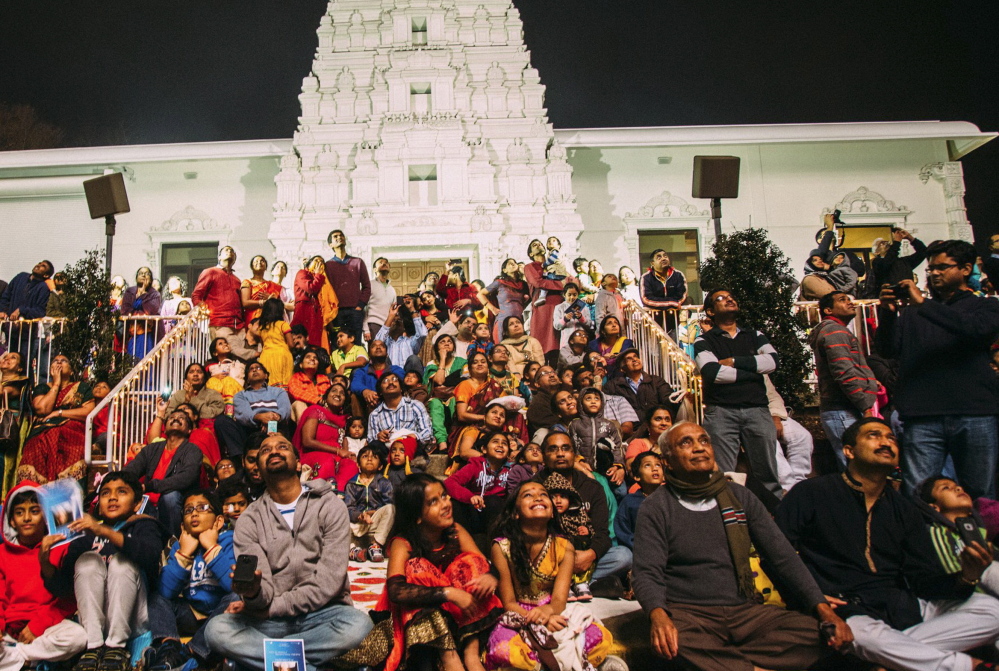PITTSBURGH — Seated in front of the floodlit, intricately sculpted façade of their Hindu temple in Penn Hills, Pa., hundreds of people recently looked into the October night sky, their faces glowing with the colors of fireworks bursting overhead to mark Diwali, a sacred festival of lights marking a god’s victory over darkness and ignorance.
People travel from across North America to make pilgrimages to the Sri Venkateswara Temple there.
Built in the mid-1970s and based on a much larger shrine in South India, the Pittsburgh version is renowned for its pioneering role in recreating on American soil the architectural grandeur and sacred sense of a major shrine in Hinduism’s native land.
Being able to make the regular trip there from his home in suburban Pittsburgh is so important to Srini Bellamkonda that the software engineer – who was transferred by his company to the United States from his native India in 2001 and came to Pittsburgh in 2004 – hasn’t sought transfers anywhere else since.
In fact, he knows of fellow Indian immigrants who left Pittsburgh for jobs in Texas or Florida – only to return.
“This is important to us, definitely,” said Bellamkonda, 40, after he helped a neighbor’s young son light a sparkler to celebrate Diwali. “They might not like the weather so much (but) the temple is one reason why people want to stick to Pittsburgh.”
Of all the Pittsburgh area’s immigrant groups, its 10,000-strong Indian-born community has made the most visible imprint on the city’s diverse religious scene. Many immigrated since the 1960s to work as engineers in corporations such as Westinghouse and in the city’s academic and medical centers.
Indian-Americans have organized two major Hindu temples and other smaller Hindu institutions, as well as a Jain shrine, a Sikh temple and small Christian congregations, including a Catholic group worshiping in the ancient Syro-Malabar tradition. Muslim immigrants from India are also active in the region’s mosques.
Earlier in the Diwali festival at the Sri Venkateswara Temple, the full, sensory worship experience of Hinduism was much in evidence. Priests chanted in urgent tones to the backdrop of bells, drumbeats and declamatory notes from wind instruments known as nadaswarams.
Worshipers prayed before the idol of the deity to whom the temple is dedicated – Sri (Lord) Venkateswara, an incarnation of Vishnu, surrounded by consorts Lakshmi and Bhoodevi, goddesses of wealth and the earth. The deities were surrounded by gifts such as floral garlands, mango leaves and rice.
From the temple’s modest origins, “it’s grown, grown and we have a lot of devotees from all over the country now,” current temple chairman Ashok Sarpeskar said.
In Monroeville, Pa., a few miles from the Sri Venkateswara Temple, the Hindu Jain Temple features elaborate turrets and other architectural flourishes.
Inside are five major shrines to deities primarily venerated in northern India, one of them especially by Jains, followers of a religion historically connected to but distinct from Hinduism.
Send questions/comments to the editors.



Success. Please wait for the page to reload. If the page does not reload within 5 seconds, please refresh the page.
Enter your email and password to access comments.
Hi, to comment on stories you must . This profile is in addition to your subscription and website login.
Already have a commenting profile? .
Invalid username/password.
Please check your email to confirm and complete your registration.
Only subscribers are eligible to post comments. Please subscribe or login first for digital access. Here’s why.
Use the form below to reset your password. When you've submitted your account email, we will send an email with a reset code.